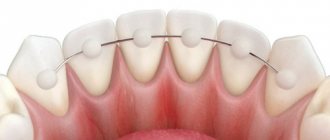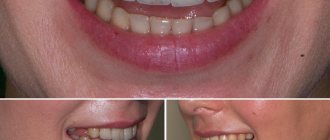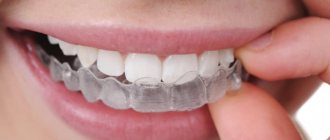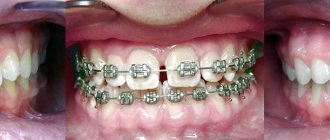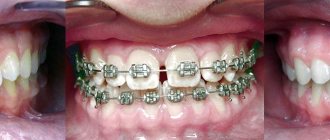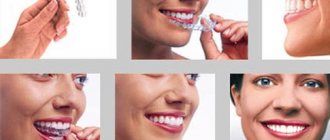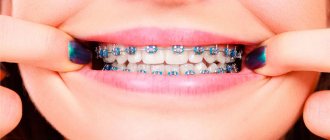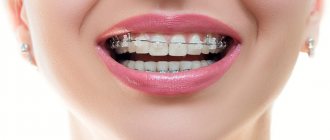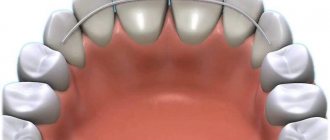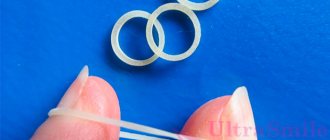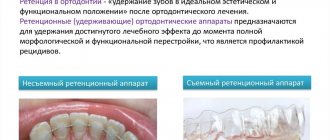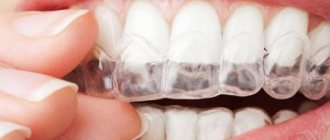Retainers are structures that play a role in occlusion correction. These orthodontic adjustments are only placed after the braces are removed. Their use is possible during the recovery period of the treatment - right at the moment of getting rid of those devices that were installed before.
By design, it is customary to distinguish two types of retainers:
- A transparent, pliable plate with a smooth surface.
- A thin wire (arch) attached to the inside of a row of teeth.
Devices can also be combined.
Content:
- The result must be confirmed
- What to wear after braces
- What is placed after braces - choosing the optimal design 3.1. Mouthguards for securing the correct bite 3.2. Retainers for correcting occlusion
- Which system to choose
- Advantages and disadvantages of caps
- Pros and cons of retainers
Many patients in dental clinics mistakenly think that immediately after removing braces, their problems will end - their teeth will become perfectly straight, healthy and beautiful, and they will no longer have to endure the discomfort associated with the pressure on the dentition of the leveling system.
Actually this is not true. When the braces are removed, the treatment does not end.
The doctor conducts an examination and, based on the information received, decides which fixation mechanisms are suitable for the client in order to consolidate the achieved result and prevent “rollback”.
The result must be confirmed
The braces system is used to ensure that crooked teeth take the correct positions and form one even and beautiful row. They allow you to correct your bite and eliminate problems caused by occlusion.
The difficulty is that not only the teeth, but also the bone tissue in which they are fixed must get used to the new position. Otherwise, a few will soon take a more familiar position.
Under the pressure of the leveling apparatus, the units are displaced. Because of this, small empty areas form in the bone tissue. As soon as the orthodontist removes the retaining elements, you need to immediately fix all units of the row in the correct position. This will prevent their roots from returning to the vacated areas of the jawbone.
What should be done at the retention stage?
The point of this stage is to gradually strengthen the jaw tissue along with the new position of the roots of the teeth. It is impossible to speed up this process. But you can help your teeth during this period:
- Eat more solid foods - raw vegetables and fruits. This is a kind of “charging” that strengthens the gums and roots of the teeth. When teeth are stressed by chewing solid food, they perform their function to the maximum, which means that the roots receive sufficient blood supply in return. This helps maintain healthy teeth and gums.
Hard raw vegetables and fruits - as an “exercise” for teeth
- Eat foods that contain enough calcium and phosphorus. These are the main building materials for bone tissue. They are found in cottage cheese, cheese, turkey, fish, nuts, and sesame. The decision about whether you need to take additional mineral supplements in the form of tablets is made after consultation with your doctor.
- Do not forget about visiting an orthodontist once every 6 months, at least in the first year and a half after the end of treatment. It is much easier for the doctor to notice the slightest deviations in the position of the teeth from the result that was achieved. If necessary, the doctor will suggest correction methods or recommend extending the retention period.
Other articles:
- Can veneers correct crooked teeth?
- Lingual braces 2d
- What can aligners do?
What to wear after braces
The time during which the results of orthodontic treatment are consolidated is called the retention period. The device that the patient will use for final restoration is a retainer or dental mouthguard.
Which system the doctor will tell the patient to use and how long the orthodontist’s prescriptions will have to be followed directly depends on:
- features of bite;
- the severity of the dental anomaly being treated;
- patient's age;
- individual characteristics of the human body.
The retention period most often lasts from six months to two years. It is important to be patient and go through it to the end. Otherwise, all previously achieved results may come to naught.
How are braces removed from teeth?
Most patients know virtually nothing about how braces are removed. The procedure is simple and involves several manipulations. Before the doctor begins work, you can ask him how long it takes to remove braces. As a rule, regular clasps are removed in about twenty minutes, and a lingual system in just under an hour. Any orthodontist can remove braces, regardless of whether the person is his patient or not.
The process of removing braces involves several stages.
- Preparation.
A retractor is installed for the patient to protect the oral mucosa from damage. - Removal of the structure.
The ligatures and arches are removed first, then the braces themselves. - Grinding.
Remains of glue are removed from the teeth by polishing, and the enamel is coated with a remineralizing composition.
Does it hurt to remove braces? Definitely not. Dental procedures cause some discomfort, but the discomfort is quite minor and mainly depends on the individual pain threshold.
What is placed after braces - choosing the optimal design
There are various devices that consolidate the effect of orthodontic treatment. Conventionally, all of them can be divided into two groups - removable and non-removable. The first includes different types of dental guards, the second includes retainers.
Mouth guards to secure the correct bite
Removable aligners are transparent products made of biological polymer. In size and shape, they exactly replicate the dentition of the person for whom they were made. They are usually made using casts of the patient. Only sometimes (usually in the simplest and most unused cases) are standard (universal) models used.
The aligners are put on immediately after the braces are removed. They need to be worn around the clock, taking breaks only for:
- eating;
- carrying out hygiene measures (brushing teeth).
Under the gentle pressure of the tray, the teeth get used to being in the position they should be in. Gradually, the doctor will reduce the duration of wearing the removable device. It will get to the point where you only need to wear it to sleep at night.
Mouth guards made from medical silicone are considered the most comfortable and functional today . They are quite soft, do not rub the gums and do not irritate the mucous membranes of the oral cavity. Their important advantage is low visibility to others. Therefore, a person can smile, laugh, and talk loudly without hesitation.
The silicone systems are very easy to put on and take off. The dentist teaches this to the client.
Retainers for correcting occlusion
Here we are talking about non-removable systems. They are glued to the inside of the teeth shortly after the braces are removed. The new elements are softer and do not cause such strong discomfort as braces. Meanwhile, they need to be carefully looked after - it is important not to allow food residues to be deposited on their surface , as this will lead to caries.
The retainer is usually made of metal. It is made in the form of an arch, repeating the dentition. It is glued to the dental surfaces using special dental cement.
You should not be afraid that after fixed systems the appearance of your teeth will deteriorate - this is not the case. After removing them, the doctor grinds the crowns. As a result, the latter become perfectly smooth.
Fixed retainers
To create a permanent retainer, a twisted metal wire is used, which is fixed to the back wall of the teeth. This design is very popular due to its ease of use and aesthetic appearance.
The orthodontist treats the enamel with a special agent that improves the adhesion of teeth to the composite adhesive material. The process is very quick and absolutely painless. Typically, a person who has worn braces for a long time and has become accustomed to them does not experience the slightest discomfort from installing a permanent retainer.
Which system to choose
No one except the orthodontist can decide which device is suitable for the patient. The selection of the system is carried out strictly individually, taking into account the characteristics of the clinical situation.
In the most difficult cases, it may be necessary to use two types of mechanisms at once. So, a person wears retainers on his teeth around the clock, and at night he additionally puts on a mouth guard to increase the pressure created.
Types of retainers
Removable retainers
There are several types of removable retainers:
- Plastic transparent mouth guards
- Metal arc
- Plate
The patient can wear removable retainers only at night or wear them during the day , this depends only on the doctor’s instructions. In any case, it is impossible to eat with such a design, therefore, if the patient must wear a retainer during the day, he needs to have a special box with him, where the retainer can be folded during meals.
Advantages and disadvantages of caps
The use of mouthguards is characterized by the following advantages:
- There are no difficulties in cleaning your teeth. The structure is removable, so a person can carry out standard hygiene measures without any restrictions.
- There are no dietary restrictions to follow. During the retention period, you are allowed to eat hard and sticky foods.
- Silicone elements do not break , which means there are no problems with their repair.
Among the disadvantages of these systems, orthodontists name:
- Lack of control over the patient's actions. A person may be irresponsible about the need to wear a structure and often take it off.
- Risk of forgetting to put on a mouthguard. This probability is especially high if it is used only at night.
Removable raters
Probably, the plastic mouth guard has the most aesthetic appearance among all removable retainers. The product is completely transparent and invisible to others during a conversation. Unfortunately, a mouth guard, like all removable retainers, can affect diction and must be removed while eating.
If the orthodontist allows the patient to wear a mouth guard only at night, then wearing it for a very long time will not cause any discomfort and may remain a secret even to those closest to you.
Pros and cons of retainers
Among the advantages of such elements:
- Aesthetic appearance. Since they are attached to the back of the teeth, they are absolutely invisible to others.
- There is no need to control the wearing of the product. A person cannot forget to put on a retainer because it is constantly in his mouth.
- Guaranteed good results. Any element located in the oral cavity causes some discomfort. Then a person can consciously remove it for one or several days. This leads to a “rollback” in treatment. You cannot remove retainers and then put them on yourself. And this is good.
As for the minuses, these are:
- Difficulties in carrying out hygiene procedures. As in the case of braces, the patient has to use an irrigator, floss, and a properly selected brush in order to efficiently clean the enamel from plaque.
- The need to avoid eating hard and sticky foods. They get stuck under the archwire or stick to it, which complicates hygiene.
- Inability to fix a loose element yourself. If it happens that some part of the retainer comes away from the teeth, the patient needs to immediately go to the dentist. He won't be able to do anything at home.
Trust your doctor and use exactly the leveling device he told you to use. Do not try to arbitrarily shorten the duration of the retention period. This will ruin all your progress. Then you will have to re-install braces and start all over again.
Features of the retention period
Wearing non-removable retainers does not require any special operating conditions. You should exclude solid foods and the habit of gnawing anything from your diet. In the process of oral hygiene, toothbrushes with soft bristles, as well as dental floss and irrigator are used.
Removable retainers require more care. It is necessary to clean the product daily with a paste and brush, rinse it before use, store it in a container, and treat it in a special solution once a week.
The removable type of retainer should differ depending on the application on the upper or lower jaw, since the lower dentition is more difficult to correct, and therefore the likelihood of the teeth returning to their previous position is higher. If the products are damaged, they must be replaced.
Immediately after the braces are removed, pain may occur. This is explained by the fact that the teeth have been subjected to stress for a long time and after eliminating the impact on them, the jaw muscles relax. Orthodontists also explain tooth pain by the process of returning teeth to their original place. Once the retainers are installed, the pain should disappear. Although the orthodontic retainers themselves do not exert any noticeable pressure.
